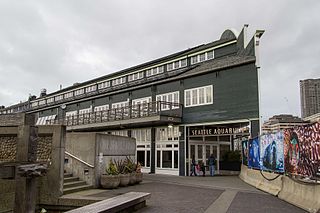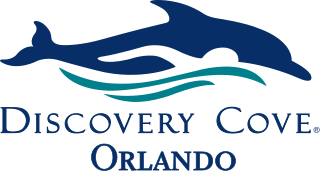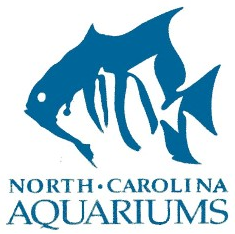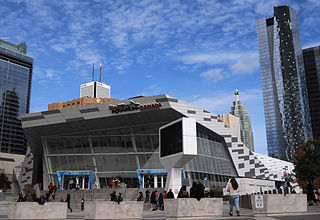
The National Aquarium – also known as National Aquarium in Baltimore and formerly known as Baltimore Aquarium – is a non-profit public aquarium located at 501 East Pratt Street on Pier 3 in the Inner Harbor area of downtown Baltimore, Maryland in the United States. Constructed during a period of urban renewal in Baltimore, the aquarium opened on August 8, 1981. The aquarium has an annual attendance of 1.5 million visitors and is the largest tourism attraction in the State of Maryland. The aquarium holds more than 2,200,000 US gallons (8,300,000 L) of water, and has more than 17,000 specimens representing over 750 species. The National Aquarium's mission is to inspire conservation of the world's aquatic treasures. The aquarium's stated vision is to confront pressing issues facing global aquatic habitats through pioneering science, conservation, and educational programming.

Shedd Aquarium is an indoor public aquarium in Chicago. Opened on May 30, 1930, the 5 million US gal aquarium holds about 32,000 animals and is the third largest aquarium in the Western Hemisphere, after the Georgia Aquarium and Monterey Bay Aquarium.

The Seattle Aquarium is a public aquarium in Seattle, Washington, United States, located on Pier 59 on the Elliott Bay waterfront. It opened in 1977 and has been accredited by the Association of Zoos and Aquariums (AZA).

Omaha's Henry Doorly Zoo and Aquarium is a zoo in Omaha, Nebraska. It is accredited by the Association of Zoos and Aquariums and a member of the World Association of Zoos and Aquariums. In August 2014, TripAdvisor rated it the "world's best zoo", ahead of the San Diego Zoo and Loro Parque, based on an algorithmic assimilation of millions of reviews for 275 major zoos worldwide.

The New England Aquarium is a nonprofit organization located in Boston, Massachusetts. The species exhibited include harbor and northern fur seals, California sea lions, African and southern rockhopper penguins, giant Pacific octopuses, weedy seadragons, and thousands of saltwater and freshwater fishes. In addition to the main aquarium building, attractions at Central Wharf include the Simons Theatre and the New England Aquarium Whale Watch. More than 1.3 million guests visited the aquarium each year prior to the outbreak of the COVID-19 pandemic.

The Aquarium of the Pacific is a public aquarium on a 5-acre (20,000 m2) site on Rainbow Harbor in Long Beach, California, United States. It is situated across the water from the Long Beach Convention Center, Shoreline Village, and the Queen Mary Hotel and Attraction.

The National Marine Aquarium, which opened in May 1998, is situated in Plymouth in south-west England. It is the largest aquarium in the UK, home to over 5,000 animals.

Discovery Cove is a theme park owned and operated by SeaWorld Parks & Entertainment, and located in Orlando, Florida. It is the sister park of SeaWorld Orlando and Aquatica Orlando. Visitors to the park can interact with a range of marine animals including bottlenose dolphins.

Underwater World, also known as Underwater World Singapore Pte Ltd, was an oceanarium located on the offshore Singaporean island of Sentosa. It was opened on 13 May 1991 and closed on 26 June 2016.

The ABQ BioPark Aquarium, located in Albuquerque, New Mexico, United States is a facility of the Albuquerque Biological Park and is located next door to the ABQ BioPark Botanic Garden. The ABQ BioPark Aquarium exhibits Gulf of Mexico and South Pacific saltwater species from a variety of habitats, including surf zone, shallow waters, coral reefs, open ocean and deep ocean. The highlight of the aquarium is a 285,000 U.S. gal (1,080,000 L) shark tank with a 38-foot (12 m)-wide, 9-foot (2.7 m)-high, 8-inch (200 mm)-thick acrylic viewing window.

The Texas State Aquarium is a nonprofit aquarium located in Corpus Christi, Texas, United States. It aims to promote environmental conservation and rehabilitation of the wildlife of the Gulf of Mexico. It has been accredited by the Association of Zoos and Aquariums (AZA) since 1995. It is the largest aquarium in Texas and one of the largest aquaria in the United States.

National Aquarium Denmark, Den Blå Planet is a public aquarium in Denmark. The original aquarium was located in Charlottenlund, but this facility closed in 2012 and most of the animal collection was relocated to the new and much larger aquarium Den Blå Planet in Kastrup, a suburb of Copenhagen. The National Aquarium Denmark, Den Blå Planet opened to the public in March 2013 and is the largest aquarium in Northern Europe.

UnderWater World Guam is one of the longest tunnel-aquariums in the world and the only oceanarium in the United States territory of Guam.

North Carolina Aquariums is a system of three public aquariums located in Kure Beach, Roanoke Island and Pine Knoll Shores. All are operated by the Aquariums Division of the North Carolina Department of Natural and Cultural Resources since 1976 and were accredited by the Association of Zoos and Aquariums. All three aquariums feature dive shows, live animal encounters, and feeding programs.

Downtown Aquarium is a public aquarium and restaurant located in Houston, Texas, United States that was developed from two Houston landmarks: Fire Station No. 1 and the Central Waterworks Building. The aquarium is located on a 6-acre (2.4 ha) site at 410 Bagby Street in downtown Houston. It houses over 200 species of aquatic animals in 500,000 US gallons (1,900,000 L) of aquariums. The complex includes two restaurants, a bar, and banquet facilities. It offers programs such as Marine Biologist for a Day, Zoologist for a Day, Sea Safari Camp, overnight stays and more. The education department works with school groups and conducts outreach programs.
The Aquarium of Boise is a 501 c(3) non-profit aquarium in Boise, Idaho, United States. It opened to the public in 2011.

Ripley's Aquarium of Canada is a public aquarium in Toronto, Ontario, Canada. The aquarium is one of three aquariums owned-and-operated by Ripley Entertainment. It is located in downtown Toronto, just southeast of the CN Tower. The aquarium has 5.7 million litres of marine and freshwater habitats from across the world. The exhibits hold more than 20,000 exotic sea and freshwater specimens from more than 450 species.

Tropicarium Kolmården is a public aquarium and terrarium, situated outside Kolmården Wildlife Park, close to Bråviken and 25 km (16 mi) from Norrköping town in Sweden. Kolmården Tropicarium is one of Sweden's largest tropical exhibitions with a covered area in excess of 2,000 m2 (22,000 sq ft).

Eilat's Coral World Underwater Observatory is a public aquarium, park and conservation center located in Eilat, Israel. It is the biggest public aquarium in Israel, and it hosts over 800 species. It was founded in 1974 and was the first of its kind. The park and aquarium is located to the south of Eilat's Coral Beach nature reserve.
The Shreveport Aquarium is an aquarium located in Bossier City, Louisiana, United States.





















